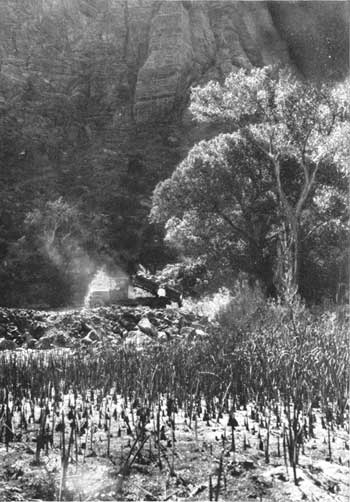![]()

Fauna Series No. 2
![]() Part II
Part II
Fauna of the National Parks
of the United States
PART II
REPORT CONCERNING OVERGRAZING AS A LANDSCAPE PROBLEM
Submitted to the Chief of the Branch of Plans and Design, National Park Service, May 28, 1934
Copy of Mr. Frank E. Mattson's memorandum to you, relative to overgrazing in northern Yellowstone as a landscape problem, has been received and read with much interest. I think that Mr. Mattson has described the situation just as it is and has drawn the only conclusion that can be drawn from such a circumstance, namely, that this overgrazed condition is not only a wildlife problem but a landscape and forestry problem as well.
EFFECT OF WILDLIFE UPON THE LANDSCAPE
There are several cases where overgrazing has seriously changed the landscape. A few pictures, depicting representative cases, are included here because they are much easier to take than long written descriptions of the cases would be.
NEXT> Photo Collection
EFFECT OF LANDSCAPING DEVELOPMENTS UPON THE WILDLIFE
Another angle of the situation is just about the reverse of that shown in the pictures. That is, the pictures show where wildlife has damaged the landscape; the reverse order is where developments are detrimental to the wildlife. This is too long to go into, but the mere mention of a few cases is sufficient, namely, mosquito and swamp control around centers of habitation; roads and waterfowl nesting sites (see fig. 59); roads and wilderness areas; roads and mountain sheep range, as in the case of the Trail Ridge in Rocky Mountain; water utilization and fishing, as in the Never Summer Range in Rocky Mountain (see fig. 60); camp grounds, parking areas, industrial centers, and such, which take portions of winter range and are inimical to the presence of large game animals. Merely to mention these is to indicate how minutely the wildlife and landscape values dovetail.

Figure 59. – High-Line Canal along the Never
Summer Range in Rocky Mountain — a beautiful landscape scar
and a fine robber of fishing streams, beaver ponds, and game
range below.
(Photograph taken June 27, 1931, Never Summer
Mountains, Rocky Mountain. Wildlife Division No. 2303.)
Because of the same problem having at least these two aspects, each of which is handled by a separate branch of the Service, it is proposed that it would be advantageous if the Branch of Plans and Design should send to the Wildlife Division copies of reports and correspondence relative to overgrazing, erosion, and other cases where your men have noticed that animal life is destroying landscape values, and that there be a reverse exchange of data where situations warrant it. In this way it is felt that many problems which are tackled separately might find quicker and more satisfactory solution.

Figure 60. – The reverse of the story —
waterfowl nesting site makes way for road in Zion.
(Photograph taken May 27, 1931, Zion Canyon. Wildlife Division
No. 1833.)
NEXT> Research reserves
Top
Last Modified: Tues, Feb 1 2000 07:08:48 pm PDT
http://www.cr.nps.gov/history/online_books/fauna2/fauna3c1.htm
![]()